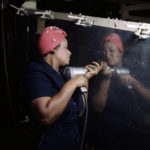Information Technologyby Deborah Prussel, WV Contributing Editor
– Dianne Gubin, Director, Los Angeles Chapter, Women In Technology (WITI) What the Book SaysThe astonishing spread of computers and information technology generated a tremendous need for highly trained workers to design and develop new hardware and software systems, maintain them and incorporate new technologies. New technology transforms systems overnight. Lumped into the occupations in the IT field are electrical and electronic engineers, computer systems analysts and scientist, operations and systems researchers and analysts, computer programmers and operators. The field employed about 1.5 million people in 1998 including approximately 114,000 self-employed, according to the 2000-2001 Occupational Handbook. The Information Technology Association of America (ITAA) study, Bridging the Gap, found the total U.S. workforce is 10.4 million, the majority of whom work for IT companies Their study also discovered that the demand in enterprise systems rose by 62% and network design/administration by 13%. Even with the economic downturn and the dot com debacle, there are not enough trained people to fill jobs. Originally it was anticipated there would be an 850,000 job going unfilled. Recent revisions decreased the number to 425,00 according to ITAA. Korn Ferry’s executive searches in the advanced technology sector increased to 29% in 2000 versus 20% in 1999. A recent survey shows that the majority of Chief Financial Officers (CFOs) plan to boost IT expenditures in the next year and a half. A bipartisan group of U.S. Senators, addressing the shortfall problem, introduced a bill providing incentives in the form of tax credits for companies to train workers in IT. In 1998, the median income of computer systems analysts was $52,180, computer engineers, $61,910, computer support specialists, $37,900, database administrators, $47,980 and all other computer scientists, $46,670. Starting salaries for college graduates is considerably higher than in many other fields and masters’ degrees push that even further. With the changing economy ITAA recommends that job candidates sharpen their professional focus in building skills and finding employment. The hottest and most in demand jobs now and in the future are technical support people. Along with college degrees, certification through vendor or industry certification programs is sometimes helpful. A recent Los Angeles Times article reported that employers though place certifications behind other attributes. Hands-on knowledge is prized with the degree. For those lacking in practical experience and education traditional for the field, then certifications help even the competitive playing field. Employers show continued interest in people with business management and closely related skills. This becomes critical, as people want to advance into managerial or project leadership positions. People skills still matter. Women’s Reality“My personal biased opinion is that we need women in tech more than ever. There are certainly loads of opportunities, although there still exist plenty of hurdles as well,” says Denise T. Drawsky, Regional Director of the San Francisco area chapter of Women In Technology International (WITI). One hurdle is pay parity. Women’s average earnings in IT are still only 85% of men, better, however than the all over average. Women earn only 18% of the doctorates in computer science in the United States. Dr. B.J. Hawkins, president of OFS, The Business Doctors, claims she is not your typical IT person. She worked in purchasing and procurement when few companies were using technology as a tool. A senior executive at Westinghouse, she left corporate America in the late 80’s because the opportunities were not there for women who were interested in profit and loss statements. “If I couldn’t run the company, then I’d form my own,” she says. That’s what she did. Though a recent Catalyst study shows that women MBA’s working in the IT industry are very satisfied with both their current positions and job opportunities, women are twice a likely to work in marketing and sales that women MBA’s in other industries. An Ethiopian native, Meskerem Tadesse, acquired her MBA in finance and marketing. With 20 years of corporate experience, she moved from Michigan to El Segundo, California six months ago to take a position as vice president for Trans National Computer Technology. When she saw the company and its synergy, she knew she could make a difference. Despite the high visibility of women like Carly Fiorina, CEO of Hewlett Packard, women are underrepresented in the IT executive ranks and the field in general. Mentoring and outreach to other women helps bridge some of the gaps. Many of the top ranking women learned how to deal with fewer female peers and not be marginalized as a lone woman working with males. With men far outnumbering women on management teams, corporate boards and in the venture capital firms, moving up the ladder requires male support. Barbra Cooper, Chief Information Officer at Toyota Motor Sales, reached the top of the tech mountain at a Japanese corporation. Cooper believes that brains, good instincts, people skills, and putting in the time required to gain the skills are necessary to scale the top ranks. “‘…Women are often better at building relationships, communicating and having the patience it takes to educate staff and users and executives on the many challenges and complexities of business and IT,'” she says. An online survey by 265 members, half in senior-level positions, of WorldWIT (Worldwide Women in Technology) illustrates that IT provides tremendous satisfaction, a sense of achievement, impact and a tremendous opportunity for creative freedom. The downside, according to the survey, reveals discrimination and stress with the latter being more frequently mentioned by survey participants. Stress includes round-the clock work life, constant change and juggling work and family and personal lives. In this horrendously fast paced field, track shoes are mandatory. Maintaining long work hours, including hours on the freeway, impacts on family life. Forty-one percent of the respondents are contemplating job or industry change. “These are good times for women. You just go over the hurdles. I never thought being a woman stood in my way in the technology field,” says Tadesse. “If you are willing to work hard, deliver and learn, you can do it.” |
||
|











